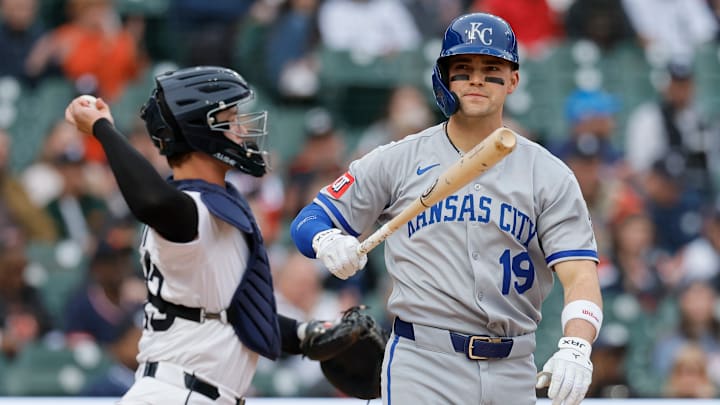After years when neither pitching nor hitting hit league-average marks, the Kansas City Royals looked like a lost cause—until 2024’s turnaround proved what elite arms and serviceable bats could accomplish. Sure, their postseason ended against a New York Yankees wall in the ALDS, but that 30-win surge underscored how far strong starting pitching and timely hitting could carry Kansas City.
Fast-forward to 2025, and it’s a tale of two teams. The Royals pitching is keeping up their end of the bargain, with a team 3.43 ERA ranking third among AL teams. But, that isn't enough to keep Kansas City above .500, as their average 2.96 runs scored each game ranks dead last in MLB. Shortstop Bobby Witt Jr. is carrying the team batting load right now, but his supporting cast is woefully underperforming as May approaches.
There is little room for optimism if Kansas City cannot turn things around at the plate. Pitching staffs cannot hold the opposition to one or fewer runs every game. At some point, the Royals will have to consistently score runs to keep their postseason hopes alive. Can the Royals’ bats awaken before it’s too late, or will another slow start derail their season? For fans still holding out hope, here are a few reasons to stay optimistic.
The KC Royals are falling far short of their expected stats.
Royals broadcasters have hammered this point home all week: when you open the box score and see Kansas City’s biggest bats silenced, it’s a real cause for concern.
Consider this: the offseason’s marquee move was adding leadoff man Jonathan India, yet his hot start has cooled off. First baseman Vinnie Pasquantino and second baseman Michael Massey aren’t lighting up the stat sheet either—so why should manager Matt Quatraro keep handing them at-bats? Simple: they’ve just been unlucky.
Every traditional stat on a baseball card has an “expected” counterpart. These metrics strip out factors like defense and ballpark quirks, isolating what hitters actually control. That’s why exit velocity and launch angle dominate MLB conversations—they’re two of the most telling indicators of success at the plate.
For this exercise, weighted on-base average (wOBA) and its expected version (xwOBA) are the ultimate measuring sticks. While xwOBA should become a household term soon, the Royals’ struggles by this metric are already glaring—and the MLB glossary offers a straightforward breakdown if fans need more context.
From team-wide to the individual level, Kansas City has one of the largest negative differences from their wOBA to xwOBA. Salvador Perez is a prime example of this. Among player's with at least 50 plate appearances this season, his -.138 difference in wOBA and xwOBA is the highest in all of baseball. The Venezuelan's .384 xwOBA ranks 33rd in MLB, while his real-world .237 wOBA ranks 159th. That is a massive drop off.
Perez isn't the only one. India, Witt, Pasquantino, and Massey are all underperforming their expected stats. That disparity at the top of the order fuels Kansas City's -.034 difference between the team's wOBA and xwOBA. That difference is the largest in the AL and the second-largest in MLB. Sure, their xwOBA ranks in the bottom five, but at least it would be an improvement upon the current production.
The KC Royals season opening gauntlet is over.
First impressions are always the lasting ones on casual baseball fans, and Kansas City had an uphill battle from the word go. The Royals started the season with seven consecutive series against teams who finished 2025 with a record above .500, with six of those same series against playoff teams from last season as well. The Royals went 9-14 in that stretch, with an abysmal 2-8 roadtrip to close things out.
Thankfully, the upcoming schedule is a little easier. Entering last night's contest, twenty-four of the Royals' upcoming 28 games are against non-division foes, with only three series of the next 11 against postseason teams from last year. While dates against the Houston Astros and Baltimore Orioles may provide an October preview, a softer schedule gives Kansas City a wider path back to .500 early in the season. But, that all depends on if the Royals can claw back to average at the plate and the pitching remains elite, especially in the rotation.
The Royals are facing some of the worst teams in baseball across the next month, such as the Colorado Rockies and division foe Chicago White Sox. One reason Kansas City racked up wins in 2024 was that they handled business against lesser opponents. Can they do so again in 2025? Well, the opposition on the mound should help their case.
Upcoming opponents' pitching staffs are softer competition.
This coincides with the previous point, but it is worth reiterating. Some of Kansas City's upcoming opponents, especially the Orioles and Rockies, have some of the worst-performing pitching staffs in the league. Even though the Royals' scoring attack has been nearing "franchise history bad", there is some optimism when a moveable object faces off against the stoppable force.
The White Sox staff right now could be considered MLB's worst, with their .362 xwOBA allowed ranking dead last in the league. The Royals' pitching staff has a .308 xwOBA, just for reference. The Rockies and Orioles do not trail far behind the White Sox in that regard.
Overall, five of the next eight Royals series opponents have a below-average xwOBA surrendered. It isn't much, but Kansas City would certainly rather be facing the St. Louis Cardinals pitching staff rather than the Detroit Tigers or San Francisco Giants. Hopefully, Royals batters can find success in the margins that favor them and turn things around sooner rather than later at the plate.
